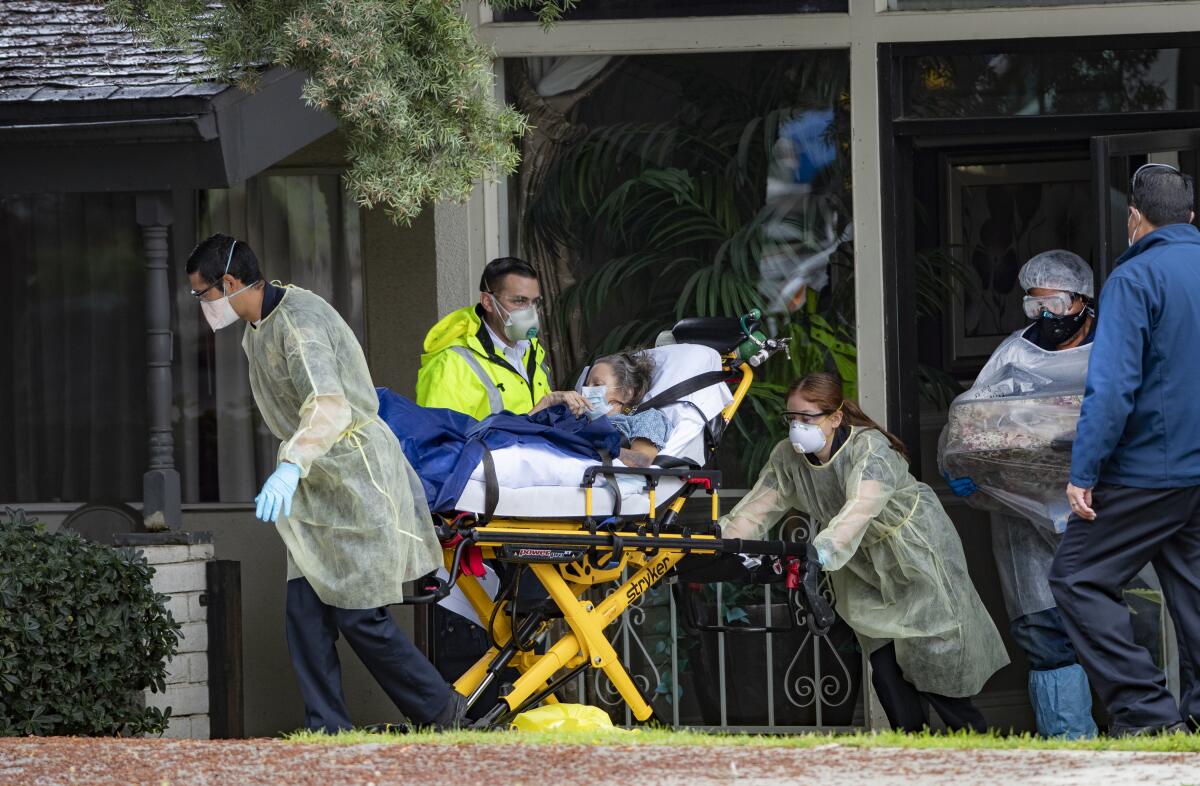Coronavirus-related death toll higher in California than previously known, new data suggest

- Share via
Total deaths across the state during the COVID-19 pandemic are more than 9% higher than historical averages, according to newly released federal statistics, suggesting the toll could be hundreds or even thousands of deaths more than what’s been attributed to the disease thus far.
The new data from the Centers for Disease Control and Prevention show roughly 4,500 additional deaths from all causes have occurred in 2020 over what would be expected from historical averages, according to a Times analysis.
With the agency’s coronavirus death total for the state at 1,017 as of Monday, the difference of about 3,500 suggests a broader implication on mortality attributable to the disease, experts say.
More Americans killed from virus than in Vietnam War
The statistics, they caution, are preliminary and more extensive research will reveal the true impact of the disease on California deaths. But they say the new figures are an important early indicator in understanding it.
“It does signal that, more likely than not, this COVID disease really did have a role in some or all of those excess deaths,” said Bonnie Maldonado, a Stanford University professor and an infectious disease epidemiologist. “The extent that it did will be important to understand.”
The federal death totals, and those attributed to the disease, lag behind those local figures, and they offer only a partial understanding of the true impact.
In California, where attention by health experts and social distancing orders perhaps slowed the coronavirus’ spread, about 1,900 deaths directly linked to the disease have been reported locally.
The newly released figures paint an even darker picture of additional mortality in states hardest hit by the disease, such as New York and New Jersey.
The data come from official death certificates completed by doctors or medical officials. They are compiled by CDC experts under a national vital statistics program that aggregates deaths reported by local and state health authorities.
On Monday, the agency released those newly compiled weekly death totals, by state, from 2014 to 2020, allowing for a mortality comparison this year over the past. It also released its own totals for coronavirus-related deaths, by county, and the total numbers of deaths from all causes.
“What we think is there is some combination of COVID deaths that are not declared COVID deaths and other deaths that are due to other causes people have not gotten treatment for, or have delayed treatment,” said Eileen Crimmins, a professor of gerontology at USC who is the president of the Population Assn. of America.
The statistics include figures for certain common types of death, including pneumonia, influenza, lower respiratory infections and heart disease. Experts say some coronavirus deaths could have been wrongly categorized, especially as widespread and rapid testing remained elusive in the pandemic’s early weeks. A catchall category for uncategorized types of death showed an increase over previous years, according to the data.
It’s possible those additional deaths are related to the disease, or related to a reluctance by some sick Californians to seek medical attention because of its presence in hospitals and clinics. The growth may also be partially attributed to population trends or a historical anomaly, or some combination of all those factors, experts say.
More research and data collection over time could help improve understanding, they say.
“You’re not going to see the full picture, but what you’ve detected is a signal, and I think that’s important,” Maldonado said. “Over time I think we’ll have a better sense of the true impact of COVID on California deaths.”
The county by county figures released by the agency, which also lag behind local reporting, allow for a comparison of coronavirus deaths and their share of total mortality in each region of the state.
In Los Angeles County, for example, the disease has been attributed to about 2.7% of deaths from all causes this year — the second-highest rate in the state after that of San Mateo County. Orange County ranks the lowest, at roughly 0.5%, among the states included in the report. The agency withheld totals from many smaller counties with low coronavirus figures.
More to Read
Sign up for Essential California
The most important California stories and recommendations in your inbox every morning.
You may occasionally receive promotional content from the Los Angeles Times.












